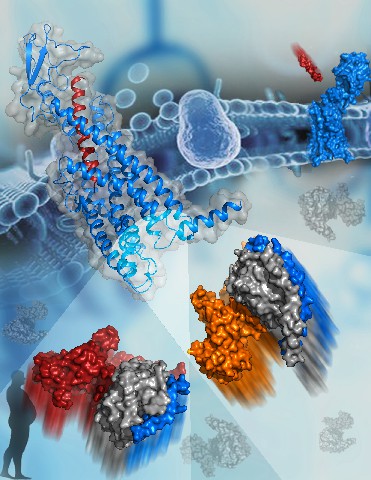

G protein-coupled receptors (GPCRs) play essential roles in cell signal transduction and serve as important therapeutic targets for a large number of diseases. Upon binding to extracellular agonists, GPCRs stimulate various signaling pathways by recruiting different G proteins (Gs, Gi, Gq, etc.) to mediate a wide variety of physiological functions. The selective coupling between a GPCR and specific G proteins is critical for the biological action of the receptor.
However, the molecular details that define how an individual GPCR recognizes different G protein subtypes remain elusive, thus limiting the understanding of mechanisms of GPCR signal transduction.

Fig. 1 The newly published science research article reports the cryo-EM structures of GCGR that play a key role in glucose homeostasis and serves as an important drug target for type 2 diabetes. The image shows the active structure of GCGR bound to glucagon (blue and red cartoon, top left corner). The two g proteins that bind to GCGR are shown as surfaces at the bottom. The subunits of Gs are colored orange, gray, and blue. The subunits of Gi are colored red, gray, and blue. [IMAGE: DOCTOR HAN SHUO OF THE SHANGHAI INSTITUTE OF MATERIA MEDICA, CHINESE ACADEMY OF SCIENCES]
In a study published in Science on March 20, a group led by Wu Beili and Zhao Qiang at the Shanghai Institute of Materia Medica (SIMM) of the Chinese Academy of Sciences (CAS), a group led by Sun Fei at the Institute of Biophysics of CAS, and a group led by Denise Wootten from Monash University determined two cryo-electron microscopy (cryo-EM) structures of the human glucagon receptor (GCGR) in complex with its cognate agonist glucagon and distinct classes of G proteins, Gs or Gi.
These structures, for the first time, provide a detailed molecular map of interaction patterns between a GPCR and different G protein subtypes, and unexpectedly disclose many molecular features that govern G protein specificity, thereby greatly deepening the understanding of GPCR signaling mechanisms.
GCGR, a member of the class B GPCR family, is critical to glucose homeostasis in that it triggers the release of glucose from the liver, making it a potential drug target for type 2 diabetes and obesity.
Although GCGR canonically exerts its physiological action through Gs signaling, it can also couple to other G proteins such as Gi and Gq, leading to diverse cellular responses. In 2017 and 2018, the scientists at SIMM determined the crystal structures of the full-length GCGR bound to a negative allosteric modulator or a partial peptide agonist, providing insights into signal recognition and modulation of class B GPCRs.
SIMM scientists have now made further progress by solving the complex structures of GCGR bound to two transducer proteins with opposing biological activities. This study offers valuable insights into pleiotropic GPCR-G protein coupling and G protein specificity. Notably, it reveals that the sixth trans-membrane helix (helix VI) of GCGR adopts a similar outward shift in the two G protein-bound GCGR structures, forming a common binding cavity to accommodate Gs and Gi. This is contrary to the hypothesis based on the previously determined GPCR-G protein complex structures, which proposed that the positional difference of helix VI is a major discriminator in the coupling specificity of Gs and Gi.
The common G protein binding pocket observed in the GCGR-G protein complex structures is consistent with the signaling pleiotropy of GCGR and allows for maximal efficiency in activating various pathways. Although GCGR couples to both G proteins through the common pocket, it does so with different interaction patterns, which account for G protein specificity. The measured interaction interface between GCGR and Gs is much larger than for Gi, resulting in higher binding affinity of Gs to the receptor. This offers a structural basis for the preferential coupling of GCGR to Gs.
Based on the structures of GCGR-Gs and GCGR-Gi complexes, the scientists performed extensive functional studies using techniques such as mutagenesis, G protein activation and cell signaling to investigate the roles of key residues in the receptor-G protein binding interface in Gs and Gi activation.
The results show that conformational differences of intracellular loops and residue side chains in the receptor are sufficient to guide G protein selectivity. The interactions contributed by the second intracellular loop (ICL2) and helix VII/VIII junction of the receptor play a crucial role in Gs coupling, while the other two intracellular loops, ICL1 and ICL3, and the receptor hydrophobic intracellular binding cavity are more important for Gi recognition.
These findings extend knowledge of GPCR activation, pleiotropic coupling, and G protein specificity. They also present new opportunities for drug discovery by designing biased ligands to selectively block one specific signaling pathway, thus resulting in reduced side effects.
The corresponding authors of the paper are Doctor Wu Beili and Doctor Zhao Qiang from SIMM, Doctor Sun Fei from IBP, and Doctor Denise Wootten from Monash University. Other notable investigators include Doctor Wang Mingwei, Yang Dehua, Qiao Anna, and Han Shuo from SIMM, Doctor Patrick M. Sexton and Zhao Peishen from Monash University, graduate student Li Xinmei from IBP, and graduate student Li Zhixin from the School of Pharmacy of Fudan University.
The study was funded by the Ministry of Science and Technology of China, the National Science Foundation of China, the Chinese Academy of Sciences, the Shanghai Science and Technology Development Fund and the Australian National Health and Medical Research Council.
For more information, please contact:
Dr. Wu Beili
Email: beiliwu@simm.ac.cn
Shanghai Institute of Materia Medica, Chinese Academy of Sciences
Source: Shanghai Institute of Materia Medica,
Chinese Academy of Sciences